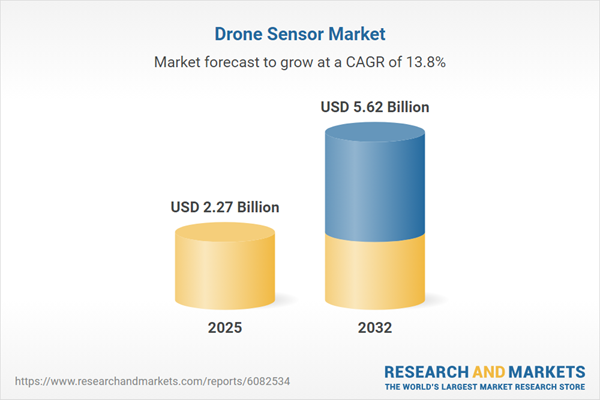Speak directly to the analyst to clarify any post sales queries you may have.
The drone sensor market is experiencing transformative momentum as cutting-edge technologies redefine aerial intelligence and commercial drone capabilities. Rapid advances across detection, processing, and regulatory adaptation are enabling organizations to achieve operational excellence.
Market Snapshot: Drone Sensor Market Performance and Outlook
The Drone Sensor Market grew from USD 1.99 billion in 2024 to USD 2.27 billion in 2025 and is projected to reach USD 5.62 billion by 2032, advancing at a CAGR of 13.84%. This sustained growth trajectory underscores expanding industry adoption, influenced by breakthroughs in sensing technology, regulatory shifts, and global demand for aerial solutions. Market momentum reflects increasing applications in sectors such as infrastructure, agriculture, and public safety as drone platforms become integral to enterprise operations.
Scope & Segmentation
This report delivers a thorough analysis of the landscape, focusing on regional developments, technology innovations, and end-user diversity. The segmentation covers:
- Platform Types: Fixed wing, rotary wing, and hybrid aerial systems highlight varying payload and operational requirements.
- Technology Types: Fiber optic sensors, microelectromechanical systems (MEMS), nano sensors, and solid-state solutions provide options for enhanced performance, lightweight payloads, and greater data fidelity.
- End Users: Commercial organizations, consumers, government & civil agencies, and military & defense bodies each shape different sensor demands and deployment profiles.
- Sensor Types: Diverse arrays including gas detection, LiDAR, multispectral, optical, radar, thermal, and ultrasonic sensors enable tailored applications from precision monitoring to safety assurance.
- Applications: Key fields such as agriculture, various delivery models (e-commerce, last mile, medical), environmental monitoring (air, water, wildlife), infrastructure inspection (bridge, pipeline, powerline), mapping and surveying, and surveillance & security (border, event, perimeter) highlight market adaptability.
- Regions: Americas, Europe, Middle East & Africa, and Asia-Pacific, featuring robust regional ecosystems and regulatory variations that influence sensor design and implementation.
- Companies Analyzed: Sony Semiconductor Solutions Corporation, OmniVision Technologies, Teledyne FLIR, Panasonic Corporation, ON Semiconductor Corporation, Velodyne Lidar, Hesai Technology, Quanergy Systems, LeddarTech, and Ouster, among others.
Key Takeaways for Senior Decision-Makers
- Recent technological advancements in miniaturization, edge-AI processing, and multisensor data fusion are enabling drone platforms to perform increasingly complex, real-time missions.
- Regulatory adaptation, including streamlined approval for advanced operations and updated cybersecurity mandates, is propelling innovation while mandating robust compliance from manufacturers.
- Demand for specialty components is reshaping supply chains, leading to new partnerships, domestic production investments, and flexible sensor architectures that improve sourcing resilience.
- Segment diversity, from government surveillance to commercial delivery and environmental stewardship, encourages adoption of specialized sensor suites that align with evolving end-user requirements.
- Key regions are deploying distinct strategies, with the Americas focusing on defense integration, EMEA leveraging modular and region-flexible sensor platforms, and Asia-Pacific advancing manufacturing scale and localized technology development.
Tariff Impact: Navigating Trade Policy Changes
The 2025 United States tariff adjustments are significantly impacting sourcing and production strategies for drone sensors. Stakeholders are responding by shifting production to less affected regions, investing in domestic manufacturing, and implementing modular sensor designs to navigate procurement uncertainties. These measures are fostering supply chain adaptability and prompting accelerated research into alternative sensor modalities.
Methodology & Data Sources
This report utilizes a multi-source research approach, integrating primary interviews with senior industry executives, structured secondary analysis of industry literature, and validation from expert advisory panels. Quantitative insights derive from shipment data, production indicators, and thorough data cleaning to ensure data integrity.
Why This Report Matters
- Offers strategic clarity for investment, procurement, and partnership decisions by mapping emerging technologies and regulatory movements in the drone sensor ecosystem.
- Delivers actionable insights for supply chain continuity and compliance in response to evolving global and regional trade dynamics.
- Enables market participants to benchmark leading companies and segment opportunities with timely, validated intelligence.
Conclusion
The drone sensor market presents compelling opportunities and operational challenges as innovation and global policy reshape industry standards. This report equips decision-makers with comprehensive intelligence for sustainable growth and value creation.
Table of Contents
3. Executive Summary
4. Market Overview
7. Cumulative Impact of Artificial Intelligence 2025
Companies Mentioned
The companies profiled in this Drone Sensor market report include:- Sony Semiconductor Solutions Corporation
- OmniVision Technologies, Inc.
- Teledyne FLIR, Inc.
- Panasonic Corporation
- ON Semiconductor Corporation
- Velodyne Lidar, Inc.
- Hesai Technology Co., Ltd.
- Quanergy Systems, Inc.
- LeddarTech Inc.
- Ouster, Inc.
Table Information
| Report Attribute | Details |
|---|---|
| No. of Pages | 199 |
| Published | October 2025 |
| Forecast Period | 2025 - 2032 |
| Estimated Market Value ( USD | $ 2.27 Billion |
| Forecasted Market Value ( USD | $ 5.62 Billion |
| Compound Annual Growth Rate | 13.8% |
| Regions Covered | Global |
| No. of Companies Mentioned | 11 |








